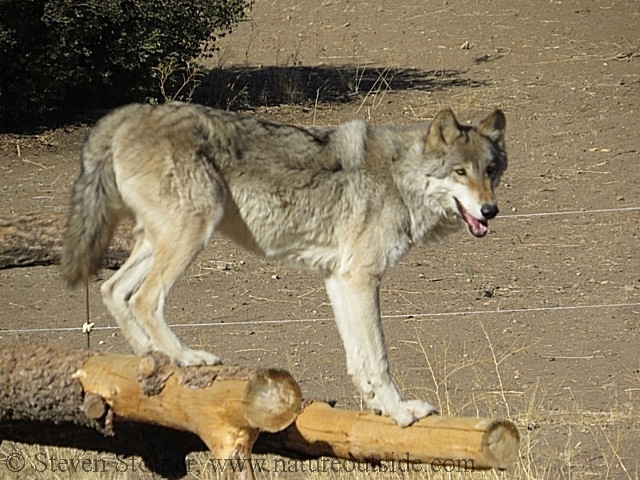
Wolf – just its name is charged with meaning. Our ancient ancestors admired the wolf for its hunting prowess. Our modern society reviles them for the same reason.
Wolves are rooted deep within the human psyche. From Little Red Riding Hood to Harry Potter, our stories cast the wolf as a hunter, a predator, swift and fearsome. A “wolf whistle” calls attention (usually unwanted) to an attractive young woman passing by a group of men. When you “cry wolf”, you falsely sound an alarm of imminent danger.
In part 1, I describe why I wanted to learn more about these ineffable creatures. In particular, I wanted to learn how to track them. I finally got that chance when I attended a “Wolf Class” given by the Earthskills School. In this post, we meet the wolves and I explain what I learned from them.
Meet Your Professors:
Professor Harley and Professor Shadow
Cave drawings in southern Europe depict wolves as long ago as 20,000 B.C. 1. Early Man most likely admired wolves for their stalking ability and hunting prowess. Ancient peoples would have modeled their own hunting techniques after wolves – using wind direction, cover, and cooperation to conceal their approach to the quarry.
It is only fitting to use captive wolves to learn about tracking them in the wild. Like our ancient ancestors, we draw lessons from observing these spectacular creatures. Professors Harley and Shadow were terrific teachers. The two gray wolves were willing and eager to display a wide variety of behaviors for their students.
Professor Harley
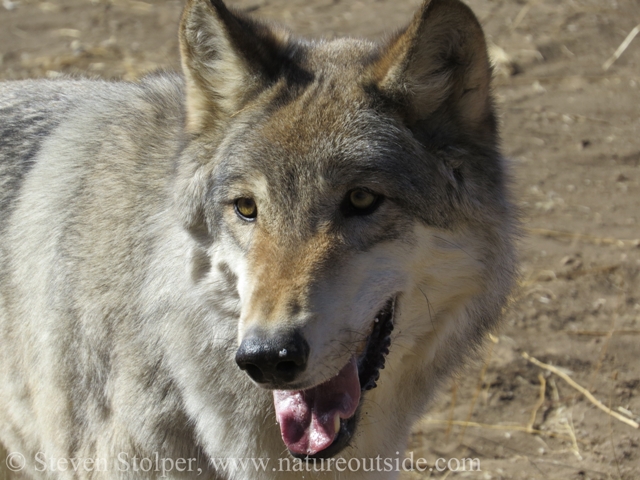
Professor Harley
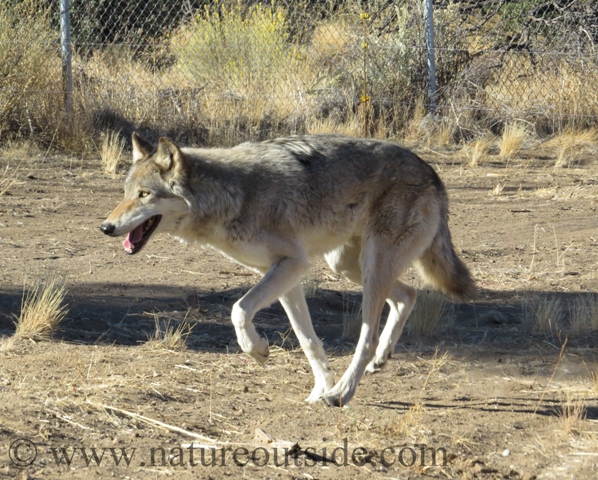
Professor Harley demonstrating for the class
Harley is the taller of the two wolves and is grey with tawny highlights. He weighs slightly less than 120 lbs. and was born in captivity, in Florida. Harley is about 5½ years old and has large feet for his size. He is full of energy and wears an expression I would describe as a “smile” as he trots around the compound we set up. Harley is a famous actor, appearing in the Bourne Legacy among his other credits.
Professor Shadow
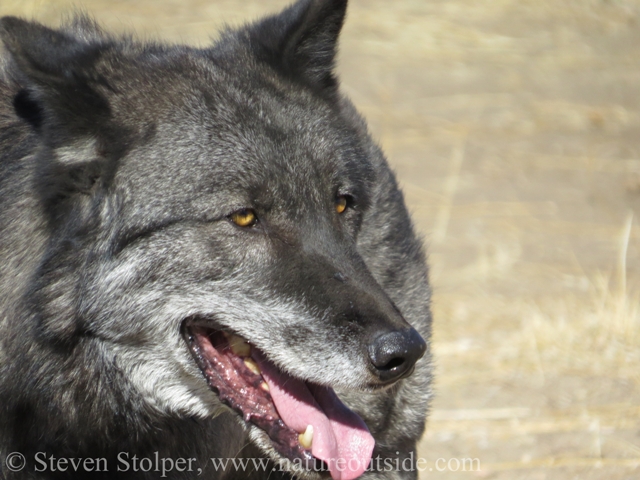
Professor Shadow
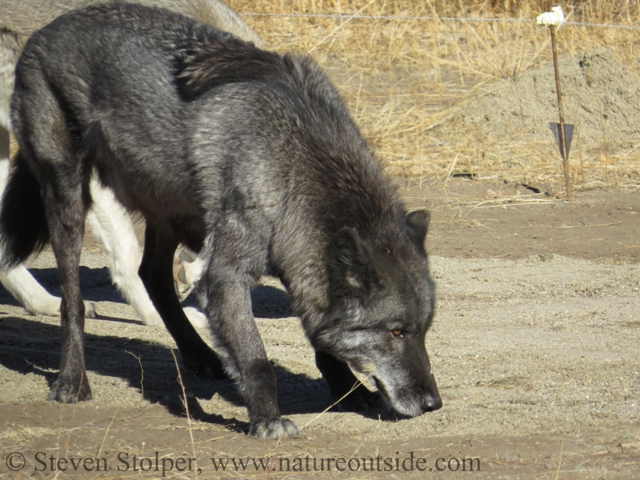
Shadow noticing the difference in texture and humidity of our sand trap
Shadow is also 5½ years old. He is a “dark phase” gray wolf born in Ohio. Shadow is lower to the ground and heavier set than Harley, weighing 115 lbs. He frequently flashed a closed-mouth expression that I could not identify.
Chris and Bobbi
Chris and Bobbi are both experienced animal trainers and clearly love working with the wolves. Chris is sometimes asked to “double” actors when the wolves perform in movies. So you may have seen him before, whether you know it or not.
For most of the session, the wolves roamed free. But there were several instances when the class wanted to see specific behaviors. Chris and Bobbi gently command the wolves to perform. Sometimes they used a small snack (a piece of brisket) as a reward. Both trainers seem to enjoy an easy relationship with the animals.
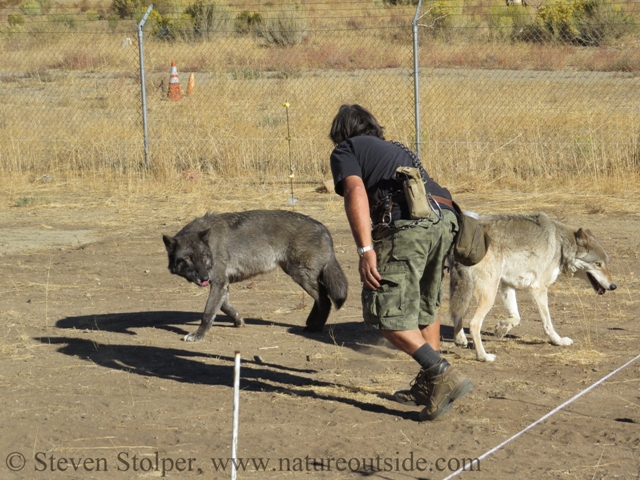
Chris is a big man. Notice the size of the wolves.
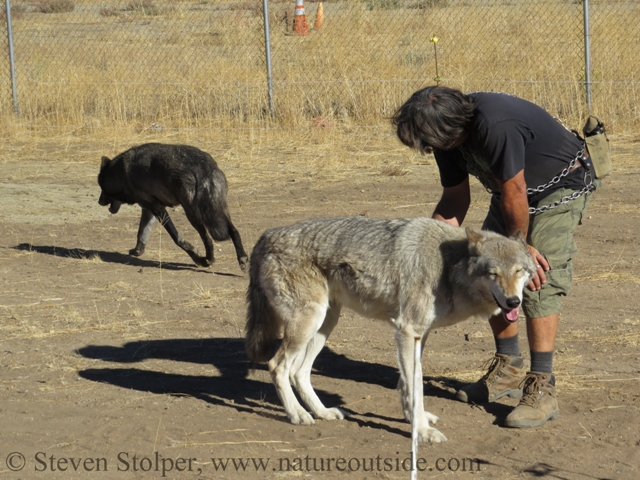
Chris and Harley enjoying a quick scratch as the wolves explore our enclosure
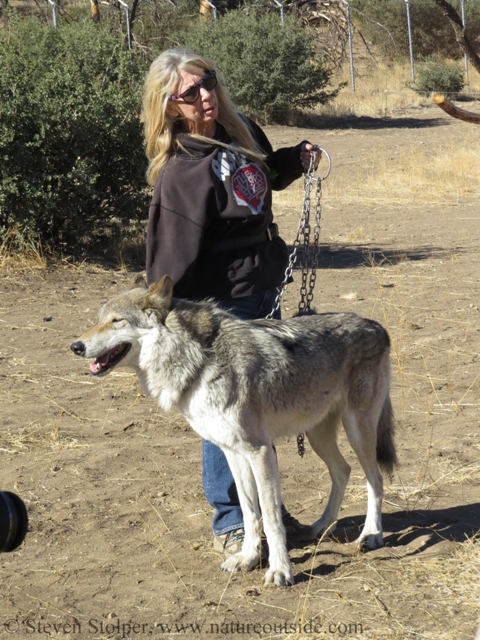
Bobbi and Harley for size comparison
First Impressions that Give One Paws
Harley and Shadow look like domestic dogs, but they’re not. They have a familiar shape, their motion is familiar, even the expressions on their faces remind me of Fido down the block. These outward similarities greatly assuaged my nervousness at meeting wolves for the first time. But there was something indefinable about them. Something that proclaimed a ‘wildness’ still resides in these captive-born animals.
Yet they seemed more obedient than the domestic dogs I know. They never strained against the leash as the trainers led them to our enclosure. Nor did they disobey the trainers, or resist returning to their cages when we wanted to inspect their tracks. They seemed happy to play and explore our enclosure. But they were still attuned to the trainers and looked for commands from them.
For their size, wolves have light bones compared to domestic dogs. They are built to run, and many of their adaptations appear geared toward that end.
They still wore their lustrous summer coats. When their winter coats grow in, it will give them a heavier appearance. I got the chance to examine some hair caught on a tree branch. To me, it was indistinguishable from domestic dog hair.
Wolves are curious creatures and they were quick to explore some dry African Lion scat lying in our enclosure. Wolves have about 200 million scent receptors compared to humans’ scant 5 million. Under favorable conditions, wolves can smell animals more than a mile (1.6 km) away1.
Harley and Shadow were initially interested in their human audience. They cruised along the hot wire boundary to inspect us at close range. But an interesting thing happened. As the wolves approached, people raised their cameras to photograph them. I was guilty of this, too. I noticed that it was like throwing up a barrier between the wolves and the humans. It prevented me from making eye contact with them or having any type of interaction. Wolves don’t have the concept of photography. So this behavior must have seemed puzzling and not particularly welcoming.
The class was coached to remain quiet and minimize movement when the wolves were near. So Harley and Shadow quickly lost interest in the strange people standing on the periphery. They became more involved with the trainers and playing with each other. In the wild, wolves are usually afraid of humans. But they have been known to respond to human howls1. I would love to witness that!
What most struck me most about the wolves was their energy. They were always in motion, circling, trotting, loping, climbing or jumping – always on the move. They circled whichever trainer held the leash like sharks circling a school of tuna. It was a happy, wild energy, always in motion.
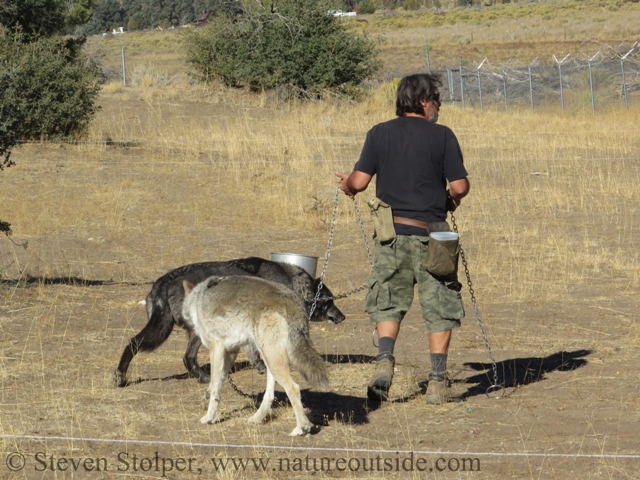
The wolves are in constant motion. When on the leash they circle endlessly.
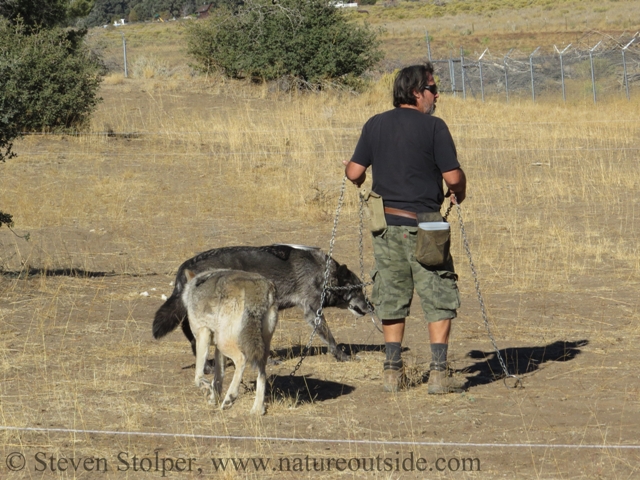
Wolves continue to circle
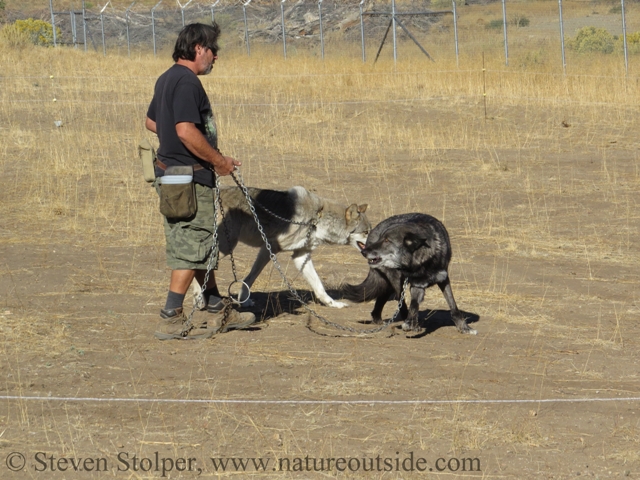
Wolves continue to circle
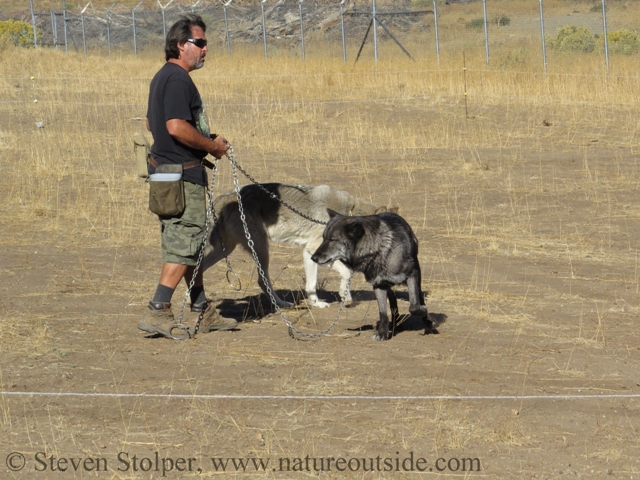
Here they complete a circle of Chris.
I enjoyed seeing them move like that. There was a definite “wolf-ness” to their constant motion. But it made photographing them very difficult. That’s my excuse and I’m sticking with it. 🙂
Gaits
The day before we met the wolves, the class spent time reviewing gaits. I define a gait as an animal’s pattern of leg movement while in motion. If you look carefully at how creatures move, you will notice that many of them share similar patterns of leg movements. The order, timing, and separation of leg movements leave a distinct track pattern on the ground.
A good tracker understands the different gaits and the track patterns they leave. He or she can look at tracks on the ground and recognize the pattern. From the pattern the tracker can visualize the movement of the animal’s legs as it left the tracks.
Gaits have always puzzled me. When I see an animal in motion, the legs move too fast for me to comprehend. So it was a small breakthrough to review gaits immediately before visiting the wolves. I saw the wolves using the gaits and was then able to look at the tracks they left behind. It went a long way toward allowing me to make the connection between track patterns and the motion of the animal’s legs.
Walk
Wolves move at a slow speed using a “diagonal walk.” The best way to understand a diagonal walk is to get down on all fours and crawl across the room. Do it, now! You will see that you move diagonal limbs on your body simultaneously. Your front right will move in concert with your rear left. Your front left will move with your rear right.
Think of it as walking like a human. We swing our opposite arm with our moving leg. For animals that direct register, the front limb begins moving just as the rear arrives from the previous step.
One visual clue for me is that limbs on the same side come close and separate, like an accordion.
Here are some pictures of Harley doing a slow walk:
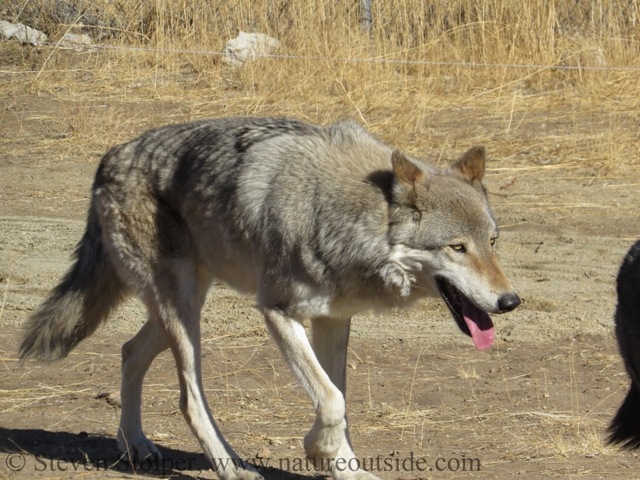
Right front begins moving just as right rear finishes previous step.
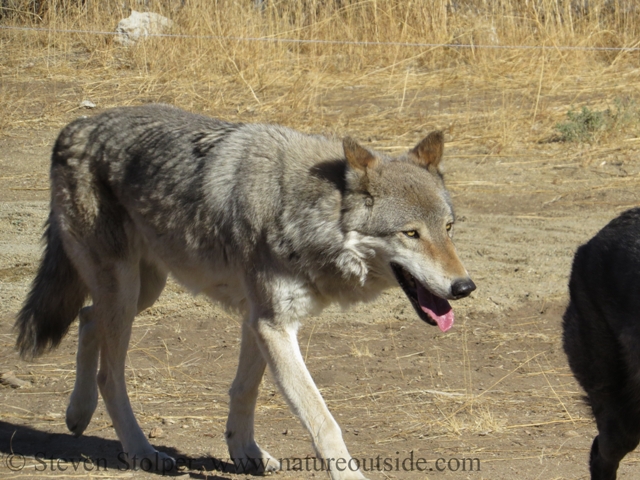
Right front and left rear are moving
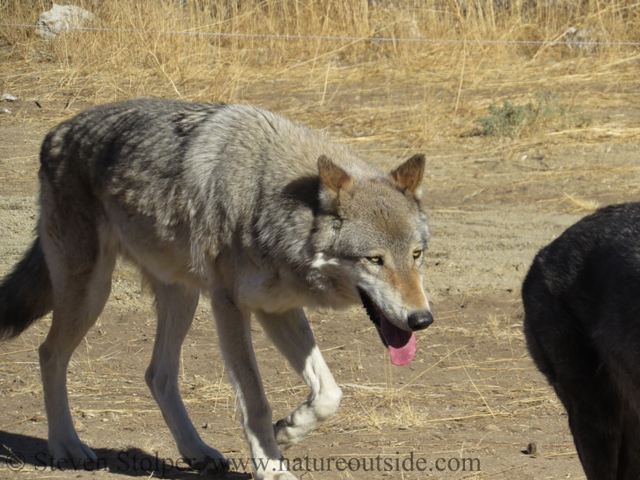
Left front begins moving just as left rear finishes previous step.
Here is some video I shot of Harley’s slow walk. I apologize for the poor quality. This is the first video I have ever taken!
Canid Trot
A trot is similar to a walk in that diagonal pairs of limbs move in concert. But a trot differs from a walk in that the animal is momentarily airborne between diagonal pairs of legs hitting the ground. A trot is a faster means of locomotion and is commonly used by wolves.
Unfortunately, I did not capture photographs or video of the wolves trotting.
Lope
A lope is similar to a gallop. The animal is momentarily airborne as it moves and the front legs land one-two and then the rear legs land one-two. But in a lope, only the “forward” hind foot lands beyond the two front tracks. The “rearward” hind foot lands either between the front tracks or on top of the most forward one. When a wolf is loping, you will see its head come up and then plunge as it moves across the ground. When the animal is moving at a lope, it is traveling at a moderate speed. A lope is usually an easygoing gait.2
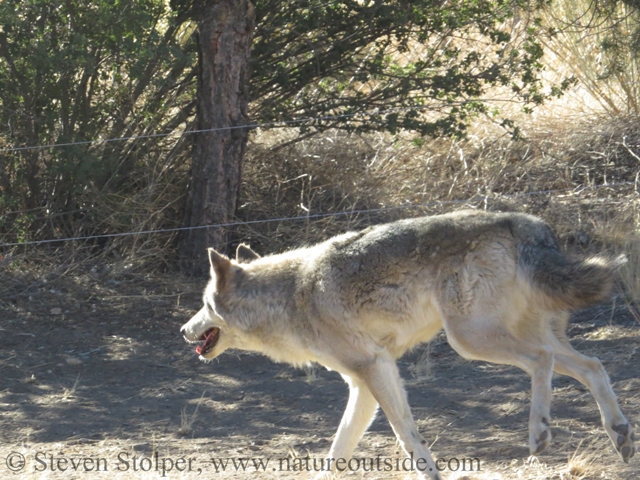
Hind legs airborne. Front legs landing separately. Head has plunged.
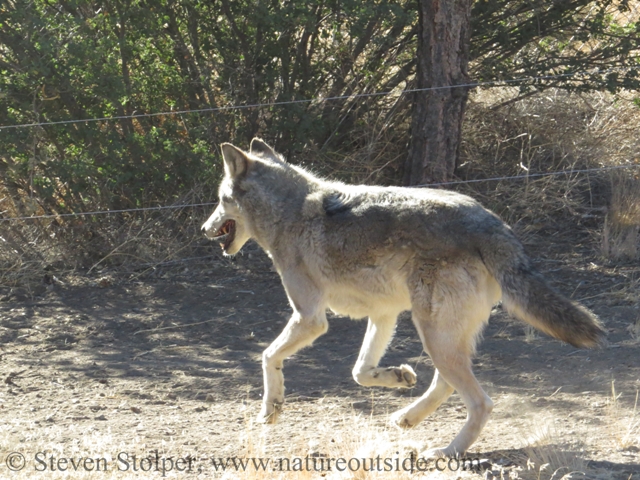
Rear legs push off separately. Wolf is airborne. Head is up.
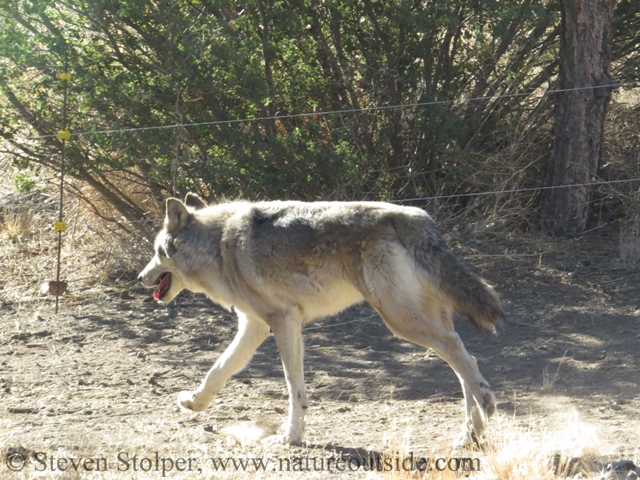
Front legs landing.
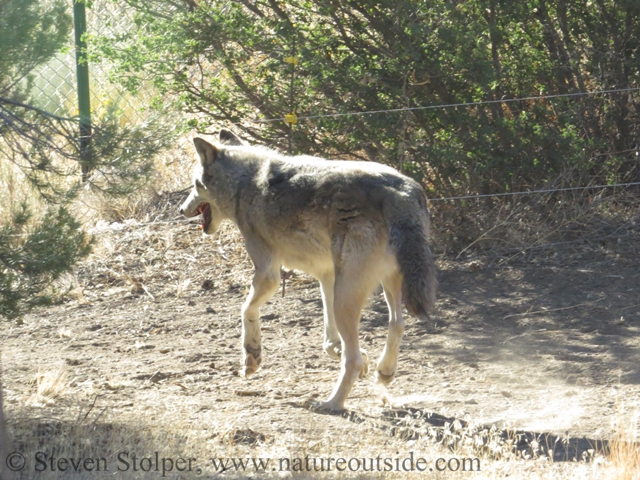
Rear legs pushing off.
Here is a video of Shadow loping:
We continue our wolf class with part 3.
References
The following are affiliate links.
1. Face to Face with Wolves, James and Judy Brandenburg.
2. Tracker’s Field Guide, James Lowery.
3. Tom Brown’s Field Guide to Nature Observation and Tracking, Tom Brown.
More Wolves on NatureOutside
Wolves Teach a Master Class (Part 1)
Wolves Teach a Master Class (Part 3)
For fun facts and useful tips, join the free Bushcraft Newsletter.



I don’t know about dog/wolf gallops, but the galloping of a horse is not front and rear pairs moving together. All four legs move independently.
I’m glad you caught that! I think the language needs to be improved. I will try to fix the wording, above, because it wrongly implies the legs move through the air in lock-step.
Post 3 in this series shows pictures of a wolf galloping.
When the animal lands after being airborne, the two front legs land in a diagonal (see post 3, picture 5 of 7). They do not necessarily strike the ground simultaneously. Then the back legs move as a pair but can be staggered as well (see post 3, picture 6 of 7). The pattern striking the ground is front-front, hind-hind (repeat). While the animal is airborne, each leg traces a unique arc to position for the next landing. The pairs of legs do not necessarily move in lock-step through the air. What makes it a gallop is the F-F-H-H pattern, where the hind legs land at or beyond the fronts.